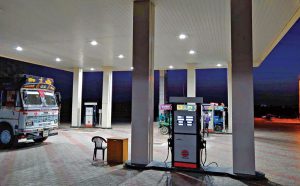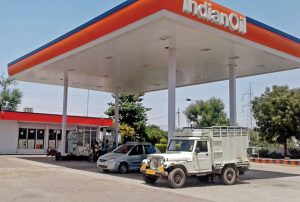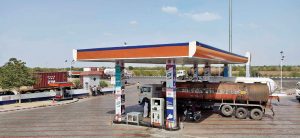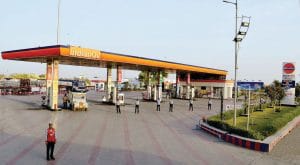The series of fuel price hikes have added to transporter challenges.
The May 11, 2021, fuel price hike pushed petrol beyond Rs.100 per litre at Parbhani in Maharashtra, and diesel within brushing distance of Rs.90 per litre. Adding to transporter challenges, the trend continues with petrol costing Rs.98.88 per litre in Mumbai and diesel costing Rs.90.40 per litre respectively at the time of going to press. Coming amid a sluggish economy and Covid-19 ravaged environment where the second wave has proved to be more devastating than the first one, the fuel price hike series, seem to be unrelenting. Adding to the transporter woes, the series of fuel price hikes are said to fuel inflation and drive the cost consumables up. Compelling a visit almost to what is termed as the steepest fuel hike ever in the country’s history, which took place mid-last year with a tax levy of Rs.10 and Rs.13 on every litre of petrol and diesel respetively, the fuel price hike series took a short break this year for state elections only. Claimed to not follow the change in international crude prices in spirit, the fuel price hikes in India, mention sources, are subject to political and economic tides. They stress that the reason given for the steep hike in excise duty mid-last year (and amid the first Covid-19 wave) was the need to sustain economically in a challenging environment.
within brushing distance of Rs.90 per litre. Adding to transporter challenges, the trend continues with petrol costing Rs.98.88 per litre in Mumbai and diesel costing Rs.90.40 per litre respectively at the time of going to press. Coming amid a sluggish economy and Covid-19 ravaged environment where the second wave has proved to be more devastating than the first one, the fuel price hike series, seem to be unrelenting. Adding to the transporter woes, the series of fuel price hikes are said to fuel inflation and drive the cost consumables up. Compelling a visit almost to what is termed as the steepest fuel hike ever in the country’s history, which took place mid-last year with a tax levy of Rs.10 and Rs.13 on every litre of petrol and diesel respetively, the fuel price hike series took a short break this year for state elections only. Claimed to not follow the change in international crude prices in spirit, the fuel price hikes in India, mention sources, are subject to political and economic tides. They stress that the reason given for the steep hike in excise duty mid-last year (and amid the first Covid-19 wave) was the need to sustain economically in a challenging environment.
When the steep fuel price hike took place mid-last year, a transporter reasoned that they would rather concentrate on matters of more immediate importance. Fuel hikes, he quipped, were never rolled back however one agitated against their rise. The demand by transporters to be given a helping hand to get back on their feet after a crippling two months lockdown did not yield any response, neither did the demand for CV drivers to be given the status of frontline wariors. The two months lockdown last year, termed as the strictest in the world, affected the economy and drove many transporters out of business as utilisation fell drastically. Refusing to stall, the fuel price hikes, starting with the steepest hike mid-last year have continued till date. By the end of 2020 – on December 07, 2021, to be precise, the price of petrol and diesel were hiked by 30 paise per litre and 26 paise per litre respectively. This elevated the price of petrol to Rs.90.34 per litre (Mumbai) and that of diesel to Rs.80.51 per litre (Mumbai) respectively. A series of near continuous price hikes post that meant petrol cost Rs.92.86 per litre in Mumbai and diesel cost Rs.83.30 per litre in Mumbai after the January 27, 2021, hike.
High taxation
Adding to t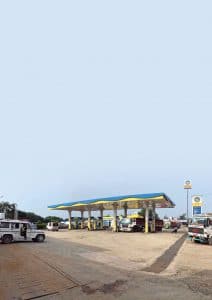 he inflationary pressure, and an economy affected badly by the Covid pandemic, petrol and diesel prices rose to Rs.97.57 a litre and Rs.88.60 a litre, respectively. The basis for this was the benchmark Brent crude, which continued to be above USD 66 a barrel. A call for lowering the taxes on fuel did not yield any response. The usual reason fowarded was the complex pricing structure of the fuel and the levy of taxes by the centre and the states. Despite much demand, petrol and diesel fuels have not been brought under GST. Mention sources that the central government currently earns an excise duty of Rs.32.90 per litre of petrol sold and Rs.31.80 per litre of diesel sold, respectively. The state governments charge a value-added tax or a sales tax on every litre of petrol and diesel sold as well, they add. The rate, it is no secret, varies across states. Explaining that the governments are not keen to bring both the fuels under the ambit of GST because they will not earn even a fraction of the taxes they are currently earning if they were to levy a tax rate of 28 per cent, sources inform that petrol and diesel rates will have to be very high. Even higher than 100 per cent, they quip. While current taxes on petrol and diesel are more than 100 per cent, the system of taxation is claimed to be lacking in transparency. Most people do not realise the high taxes they are paying, sources reveal.
he inflationary pressure, and an economy affected badly by the Covid pandemic, petrol and diesel prices rose to Rs.97.57 a litre and Rs.88.60 a litre, respectively. The basis for this was the benchmark Brent crude, which continued to be above USD 66 a barrel. A call for lowering the taxes on fuel did not yield any response. The usual reason fowarded was the complex pricing structure of the fuel and the levy of taxes by the centre and the states. Despite much demand, petrol and diesel fuels have not been brought under GST. Mention sources that the central government currently earns an excise duty of Rs.32.90 per litre of petrol sold and Rs.31.80 per litre of diesel sold, respectively. The state governments charge a value-added tax or a sales tax on every litre of petrol and diesel sold as well, they add. The rate, it is no secret, varies across states. Explaining that the governments are not keen to bring both the fuels under the ambit of GST because they will not earn even a fraction of the taxes they are currently earning if they were to levy a tax rate of 28 per cent, sources inform that petrol and diesel rates will have to be very high. Even higher than 100 per cent, they quip. While current taxes on petrol and diesel are more than 100 per cent, the system of taxation is claimed to be lacking in transparency. Most people do not realise the high taxes they are paying, sources reveal.
The transporters, it is not clear, could be among them. They are certain to be aware of the taxes and other compliance costs they are paying on diesel that they incur to operate their CVs. A strike called by the transporter bodies across the country against a steep fuel price hike in 2018 (as one of the agendas) did not yield the desired result. What it yielded instead, it looks like, were the new axle norms! The new axle norms created excess capacity in the market overnight almost.
 They followed hot on the heels of the GST that added a new element of e-way bill and forward and reverse charge mechanism. Small transporters have since found it tough to do business. Many have exited the scene and many others are on the verge of doing the same. Explain sources, that many transporters are working on negative profits. They are running the show because they have to. The most recent series of fuel prices hikes, which takes petrol beyond Rs.100 per litre and diesel closer to Rs.90 per litre, has added to their challenges in the wake of a dull economic scenario. They have had a cascading effect on the overall costs. Those who are capable of buying more efficient CVs hold a better chance. But, then the recent price hike in the region of four to five-per cent and the significant BSVI price hike haven’t been kind to the transporters either. It has been a double whammy for him. Those running their vehicles on CNG have not been very lucky either.
They followed hot on the heels of the GST that added a new element of e-way bill and forward and reverse charge mechanism. Small transporters have since found it tough to do business. Many have exited the scene and many others are on the verge of doing the same. Explain sources, that many transporters are working on negative profits. They are running the show because they have to. The most recent series of fuel prices hikes, which takes petrol beyond Rs.100 per litre and diesel closer to Rs.90 per litre, has added to their challenges in the wake of a dull economic scenario. They have had a cascading effect on the overall costs. Those who are capable of buying more efficient CVs hold a better chance. But, then the recent price hike in the region of four to five-per cent and the significant BSVI price hike haven’t been kind to the transporters either. It has been a double whammy for him. Those running their vehicles on CNG have not been very lucky either.
CNG prices
The prices of Compressed Natural Gas (CNG) have been increasing steadily even though not in tandem with petrol and diesel price hikes. The most recent hike, and a fairly substantial one, could be traced to February 2021. In order to partially cover increases in operational, manpower and fixed costs experienced during the pandemic caused by Covid-19, Mahanagar Gas Limited (MGL) increased its CNG price by Rs.1.50 per kg. CNG in Mumbai is known to currently cost a little under Rs.50 per kg. In Delhi, it is claimed to cost Rs.43.50 per kg. In India, there are about 2,208 CNG stations. The Government has announced that it wants to achieve the goal of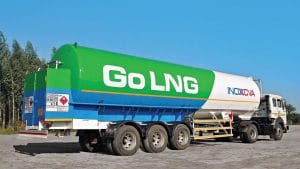 10,000 CNG stations in the country. If CNG looks like a cleaner, alternate fuel for urban fleets, LNG could be the cleaner, alternate fuel of choice for long-haul ones. The Government is said to be setting up 50 LNG stations along the Golden Quadrilateral. This would be expanded to 1,000 numbers in three years. Some eight to 10 lakh trucks are expected take to it by 2035. With long-haul fleets poised to gain from one tankful range of 700 to 750 kms of LNG, the prices of the respective fuel are expected to be attractive. If it would help the transporter’s TCO is what will make the differenace. At the end of the day, it is what will matter the most.
10,000 CNG stations in the country. If CNG looks like a cleaner, alternate fuel for urban fleets, LNG could be the cleaner, alternate fuel of choice for long-haul ones. The Government is said to be setting up 50 LNG stations along the Golden Quadrilateral. This would be expanded to 1,000 numbers in three years. Some eight to 10 lakh trucks are expected take to it by 2035. With long-haul fleets poised to gain from one tankful range of 700 to 750 kms of LNG, the prices of the respective fuel are expected to be attractive. If it would help the transporter’s TCO is what will make the differenace. At the end of the day, it is what will matter the most.




